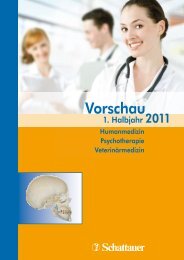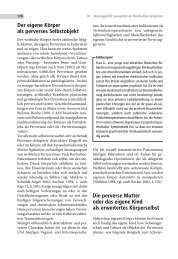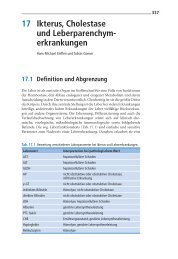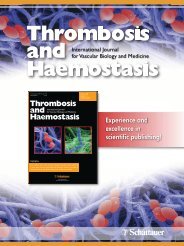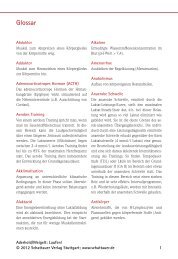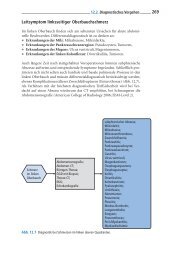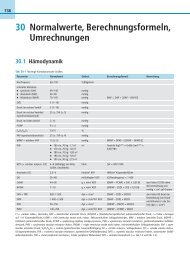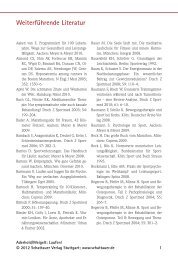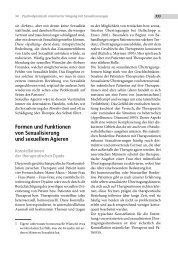DVO Guideline 2009 for Prevention, Diagnosis and Therapy of ...
DVO Guideline 2009 for Prevention, Diagnosis and Therapy of ...
DVO Guideline 2009 for Prevention, Diagnosis and Therapy of ...
You also want an ePaper? Increase the reach of your titles
YUMPU automatically turns print PDFs into web optimized ePapers that Google loves.
58 <strong>DVO</strong> <strong>Guideline</strong> Osteoporosis <strong>2009</strong><br />
7.7 Immobility<br />
Immobility is a moderate risk factor <strong>for</strong><br />
fractures (relative risk 1.5–2 times) (A <strong>for</strong><br />
women, B <strong>for</strong> men) <strong>and</strong> vertebral fractures<br />
(B <strong>for</strong> women, D <strong>for</strong> men) (E39, E40). Persons<br />
who are limited in their mobility to<br />
such an extent that e. g. they cannot leave<br />
their home or do house work (A), or who<br />
cannot walk more than 100 m (B) (E40),<br />
are regarded as immobile.<br />
7.8 Smoking<br />
For men <strong>and</strong> women smoking is an independent<br />
moderate risk factor <strong>for</strong> vertebral<br />
fractures <strong>and</strong> peripheral fractures (relative<br />
unadjusted <strong>and</strong> adjusted risk approx.<br />
1.2–1.8) (A) (E41). The dependence on the<br />
number <strong>of</strong> cigarettes has not been sufficiently<br />
examined.<br />
7.9 Underweight<br />
In the case <strong>of</strong> being underweight the<br />
relative risk <strong>of</strong> a hip fracture is approx.<br />
doubled <strong>for</strong> men <strong>and</strong> women (A). An increased<br />
risk <strong>of</strong> non-vertebral fractures (A)<br />
<strong>and</strong> vertebral fractures (B) is also shown.<br />
Underweight here is defined as a body<br />
mass index <strong>of</strong> < 20 kg/m 2 . The increased<br />
fracture risk in the case <strong>of</strong> lower weight is<br />
closely associated with reduced bone density.<br />
Being underweight, thus, is a risk factor<br />
primarily dependent on bone density<br />
(A) (E42–E44).<br />
7.10 Calcium/Vitamin D Insufficiency<br />
A serum 25-hydroxy vitamin D concentration<br />
lower than 10 ng/ml (25 nmol/l) is<br />
associated with an increased risk <strong>of</strong> hip<br />
fractures (relative risk approx. 2 times)<br />
(E45) (B <strong>for</strong> men <strong>and</strong> women). The fracture<br />
risk in the case <strong>of</strong> a serum 25-hydroxy<br />
vitamin D concentration between 10 ng/<br />
ml <strong>and</strong> 30 ng/ml (25–75 nmol/l) is insufficiently<br />
examined (D).<br />
A daily calcium intake <strong>of</strong> less than<br />
500 mg is also associated with an increased<br />
fracture rate (A <strong>for</strong> women, B <strong>for</strong> men)<br />
(E46). The association <strong>of</strong> a calcium intake<br />
<strong>of</strong> more than 500 mg per day <strong>and</strong> fractures<br />
is inconsistent (B). For persons with a calcium<br />
<strong>and</strong> vitamin D deficiency living in old<br />
people’s <strong>and</strong> nursing homes a supplement<br />
<strong>of</strong> 1200 mg <strong>of</strong> calcium <strong>and</strong> 800 units <strong>of</strong> vitamin<br />
D 3 results in a reduction in non-vertebral<br />
fractures, especially in hip fractures<br />
(A). For older men <strong>and</strong> women who live on<br />
their own <strong>and</strong> <strong>for</strong> younger persons the data<br />
from intervention studies with calcium<br />
<strong>and</strong>/or vitamin D are inconsistent (B).<br />
Since a calcium <strong>and</strong> vitamin D deficiency is<br />
a quickly <strong>and</strong> well recoverable risk factor it<br />
is not taken into consideration as an independent<br />
risk factor in the prognosis <strong>of</strong> a<br />
10-year fracture risk in chapters 8 <strong>and</strong> 10.<br />
7.11 Homocysteine, Folic Acid <strong>and</strong><br />
Vitamin B 12 Deficiency<br />
A high serum concentration <strong>of</strong> homocysteine<br />
has proved to be a strong risk factor<br />
<strong>for</strong> osteoporotic fractures in epidemiologic<br />
studies <strong>for</strong> men <strong>and</strong> women (relative risk<br />
2–3 times) (A) (E62–E74).<br />
In some studies a reduced serum concentration<br />
or intake <strong>of</strong> folic acid <strong>and</strong> vitamin<br />
B 12, nutritional determinants which<br />
considerably influence the homocysteine<br />
concentration, were associated with the<br />
fracture rate (C) (E65–E68).<br />
It is not clear if e. g. a reduced folic acid<br />
concentration <strong>and</strong> its influence on homocysteine<br />
concentration or also through<br />
other mechanisms affect the bone <strong>and</strong><br />
whether a causal relationship exists at all.<br />
Larger intervention trials on the reduction<br />
<strong>of</strong> homocysteine on the number <strong>of</strong> fractures<br />
do not exist. Furthermore, interactions<br />
with other risk factors are not<br />
known. The current body <strong>of</strong> evidence is too<br />
uncertain <strong>for</strong> recommending measurements<br />
<strong>of</strong> homocysteine, folic acid or vitamin<br />
B 12, or to give this risk factor an individual<br />
prognostic or treatment-related relevance<br />
apart from mere nutritional recommendations<br />
(D).<br />
7.12 hs-CRP<br />
The high sensitivity C-reactive protein (hs-<br />
CRP) is a sensitive marker <strong>for</strong> inflammatory<br />
diseases. Epidemiological trials have<br />
proved that hs-CRP is a moderate to strong<br />
independent risk factor <strong>for</strong> low traumatic<br />
fractures <strong>for</strong> men <strong>and</strong> women (E77b). For a<br />
systematic measurement <strong>of</strong> hs-CRP (not<br />
CRP!) the additional benefit with regard to<br />
fracture prognosis in multi-variant models<br />
which include all clinical risk factors, however,<br />
has not yet been sufficiently substantiated.<br />
There<strong>for</strong>e, a routine measurement <strong>of</strong><br />
hs-CRP in primary diagnosis cannot be<br />
recommended at present. In the case <strong>of</strong><br />
rheumatoid diseases, it is not clear whether<br />
the increased fractures risk is related to hs-<br />
CRP, there<strong>for</strong>e, independence cannot be assumed.<br />
Risks due to Comorbidities<br />
7.13 Cushing’s Syndrome<br />
Cushing’s syndrome is a strong, presumably<br />
partly independent fracture risk <strong>for</strong><br />
men <strong>and</strong> women (B) (E77).<br />
The risk is probably reversible after surgical<br />
measures (D).<br />
A subclinical hypercortisolism, e. g. in<br />
the case <strong>of</strong> an adrenal gl<strong>and</strong> adenoma, is<br />
probably a moderate independent fracture<br />
risk (C).<br />
7.14 Primary Hyperparathyroidism<br />
In some trials primary hyperparathyroidism<br />
in men <strong>and</strong> women was a moderate to<br />
strong risk factor <strong>for</strong> fractures (relative<br />
fracture risk approx. 2 times) (E76). An increase<br />
in fractures, however, was not seen in<br />
all trials (D).<br />
It is probable that the risk is independent<br />
<strong>of</strong> bone density, however, interactions<br />
with other risk factors have not yet been<br />
sufficiently examined. The increased fracture<br />
risk is reversible after surgery (C).<br />
7.15 Growth Hormone Deficiency<br />
with Pituitary Gl<strong>and</strong> Insufficiency<br />
For adult men <strong>and</strong> women a growth hormone<br />
deficiency due to pituitary gl<strong>and</strong> insufficiency,<br />
regardless <strong>of</strong> other replacement<br />
treatment, other clinical risk factors <strong>and</strong><br />
bone density, is associated with a 2–3 times<br />
higher fracture risk (B) (E77a).<br />
This risk seems at least to be partly reversible<br />
upon treatment with growth hormone<br />
(C).<br />
An insufficiency in growth hormone<br />
which is untreated or (consistent with the<br />
other recommendations) was treated <strong>for</strong><br />
less than 2 years is to be assessed as a risk<br />
Osteologie 1/2011 © Schattauer 2011



